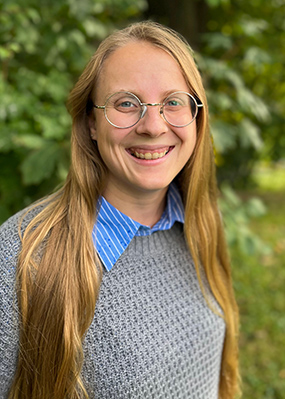Physics graduate student receives prestigious DOE grant
Michigan State University graduate student Julie Butler is the recipient of a highly competitive Department of Energy (DOE) Office of Science Graduate Student Research Program (SCGSR) grant.
Butler is one of 44 outstanding graduate students from across the nation representing 36 states in the program selected to conduct research at 12 DOE national laboratories. Each was selected through peer review by external scientific experts. Awards for this cohort were made through the SCGSR program’s first of two annual solicitation cycles for FY 2022.

Julie Butler, a graduate student in in physics and astronomy received a DOE SCGSR grant to conduct research on applications of machine learning to coupled cluster studies of infinite fermionic matter. Courtesy photo
Butler, is a Ph.D. student in the MSU College of Natural Science’s (NatSci) Department of Physics and Astronomy, and a graduate student at the Facility for Rare Isotope Beams, or FRIB. She plans to conduct her research on applications of machine learning to coupled cluster studies of infinite fermionic matter at Oak Ridge National Laboratory (ORNL) in Tennessee. Butler’s collaborating DOE researcher will be Dr. Gustav Jansen, a scientist at ORNL with a background in computational physics and specializing in high-performance computing and quantum many-body methods for nuclear systems.
“As a first-generation college student being awarded this fellowship, I hope that I can inspire others with my background to dream big and to work to achieve those dreams, even if they seem out of reach,” Butler said. “Professionally, this is a chance to work with and learn from the leading scientist in my field at the top supercomputing facility in the world. I will gain skills and connections that I would not have a chance to otherwise.”
Butler's research involves combining infinite fermionic systems, coupled cluster (CC) theory, and machine learning to produce a more accurate model of infinite systems. The project will attempt to speed up calculations in many-body nuclear physics simulations by strategically applying machine learning to accelerate convergence. Studying infinite matter systems is important as they can be used to model physical systems such as the crust of neutron stars or the electrons in a semiconducting metal.
Morten Hjorth-Jensen, Butler’s advisor and a professor of theoretical physics with FRIB, further described her research and its potential.
“This project will allow Julie to explore new and exciting research directions in computational quantum mechanics,” Hjorth-Jensen said. “The outcome of her research plans, which utilize world-leading high-performance computing resources and knowledge at Oak Ridge National Laboratory, are of great importance for nuclear physics and for our basic understanding of atomic nuclei and the research program in nuclear science conducted at FRIB. Using machine learning methods to obtain information about quantum mechanical correlations in theoretical nuclear physics will allow her to make predictions about properties of dense nuclear matter as seen in the interior of atomic nuclei and in compact objects like neutron stars. Congratulations to Julie on her well-deserved honor.”
“We are so proud of Julie’s success,” said Amy Ralston, NatSci associate dean for graduate studies. “Competing for these kinds of awards requires persistence and grit, just as much as stellar science. Julie can now inspire other MSU students to continue getting out there and being awesome!”
SCGSR awardees receive world-class training through access to state-of-the-art facilities and resources at DOE national laboratories, which allow them to conduct research on projects of significant importance to the Office of Science mission that address societal challenges at national and international scales—and help secure the U.S. position at the forefront of discovery and innovation.
“The Department of Energy is committed to growing the American science and technology workforce. SCGSRs are one way we contribute to nurturing the incredible talent and curiosity in students from all walks of life to meet the great scientific challenges of the world,” said Asmeret Asefaw Berhe, DOE Office of Science director. “I know the future is bright for these students, and I’m honored that the Department of Energy can be a part of their stories.”
Projects span the eight Office of Science research programs: advanced scientific computing research, biological and environmental research, basic energy sciences, fusion energy sciences, high energy physics, nuclear physics, accelerator R&D and production, and isotope R&D and production as well as four additional priority convergence research topical areas: microelectronics, data science, conservation laws and symmetries, and accelerator science.
A list of the 44 awardees, their institutions, host DOE laboratory/facility, and priority research areas of projects can be found at https://science.osti.gov/WDTS/SCGSR/SCGSR-Awards.
For more information on SCGSR visit https://science.osti.gov/wdts/scgsr.
Banner image: Artificial intelligence and machine learning are increasingly big news. Julie Butler's research involves combining infinite fermionic systems, coupled cluster (CC) theory, and machine learning to produce a more accurate model of infinite systems. The project will attempt to speed up calculations in many-body nuclear physics simulations by strategically applying machine learning to accelerate convergence. Credit: "Artificial Intelligence & AI & Machine Learning" by mikemacmarketing is licensed under CC BY 2.0.